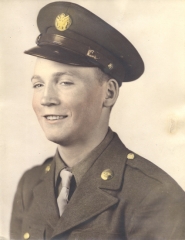Michas M. Ohnstad

Michas M. Ohnstad
MICHAS
M.
OHNSTAD
SOLDIER DETAILS
BIOGRAPHY
Michas Ohnstad was the youngest of four siblings. He was born at Hinckley, MN on 14 August 1926. He graduated from Hinckley High School May 1944 and, upon receipt of the famous 'Greetings' letter from President Roosevelt, he was drafted and inducted into the Army at Ft. Snelling, MN and further processed at Jefferson Barracks, MO in Jan 1945 and sent for armored basic training at Ft. Knox, KY. Following a brief delay-en-route (not a furlough) after basic he went by troop train (the old coal fired steam type) to Fort Ord, CA replacement depot for processing for overseas duty. He departed by troop ship from California on 7 July 1945 for a destination unannounced until at sea and after zigzagging, for security reasons, across the Pacific with a stopover in Hawaii he landed at Manila in the Philippines and then transferred to Cabanatuan, Luzon for service with the 43rd Infantry Division - Field Artillery Battalion. On 6 and 9 August 1945 President Truman ordered the dropping of the atomic bombs on Hiroshima and Nagasaki (President Roosevelt had died on 12 April 1945) and on 14 August 1945 (his 19th birthday!) it was announced that Japan had surrendered. By troop ship he was sent to Yokohama, Japan for Army of Occupation duty with the 1st Cavalry Division. On Sep 30, 1945 he received Orders from General MacArthur that read in part and in typical military shorthand: 'Following named enlisted member, now on temporary duty Advance Echelon, GHQ AFPAC, APO 500, WP Hiroshima and Nagasaki and such other places adjacent thereto as may be necessary for carrying out instructions. Upon completion of this duty, member will return Advance Ech. GHQ AFPAC, APO 500. EM auth travel between Hiroshima and Nagasaki at such times as may be necessary in the accomplishment of their mission. Member will report to Col. A.W. Oughterson for duty. Travel by military aircraft is directed for accomplishment of an emergency war mission . . . .' This order was for service with the ATOMIC BOMB COMMISSION which was composed of several American medical doctors and two or three enlisted men and a contingent of Japanese doctors and nurses and two male Japanese cooks both of whom had been combat soldiers. One of the cooks lost his wife and one child as a result of the atomic bombing of Hiroshima. The commission ate, slept and worked on site and the area was 'off limits' to area occupation troops because of radiation concerns. After the bombs were dropped early reports in the field in the Philippines indicated that 'vegetation would not grow for a hundred years' but that early report was far from reality. 'I was the only Minnesotan who served with the Atomic Bomb Commission and so at my demise that page of history will have been turned. Upon completion of the Atomic Bomb Commission assignment I served with the USA Typhus Commission in Tokyo. The task of the typhus commission was to spray Japanese civilians with DDT powder because at war's end lice were a health problem among the Japanese populace. The goal was to protect the Occupation troops from Typhus by spraying the civilian population. The Japanese welcomed the opportunity to be sprayed with the DDT powder and they lined up in long lines to await the spray treatment. Upon completion of USA Typhus Commission service my final service was in Tokyo at General MacArthur's headquarters in the Dai Ichi building. We would see General MacArthur every day. He was so disciplined that you could 'set your watch' by his departure time. The Japanese citizens had great respect for General MacArthur and in anticipation of his daily departure from the building they could be seen stopped on the sidewalk waiting for him to exit the building and to enter his chauffeured vehicle. I was returned stateside and received my Honorable Discharge after two years and eleven days with one year, four months, and two days foreign service. My rank at discharge was T/5 and I received the Asiatic Pacific Theatre Ribbon,'
 Eisenhower Foundation
Eisenhower Foundation
